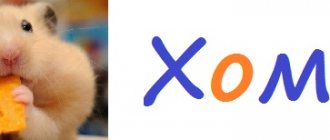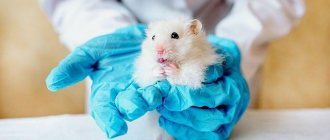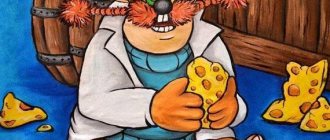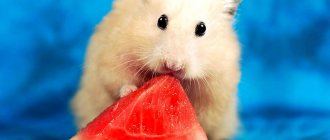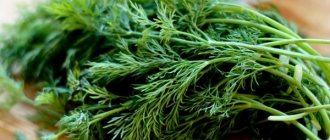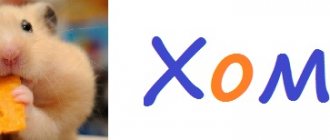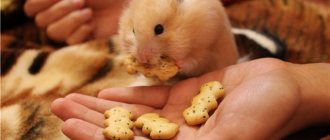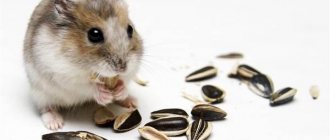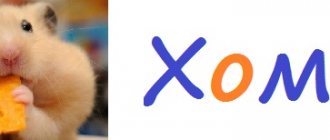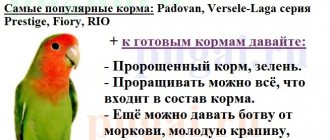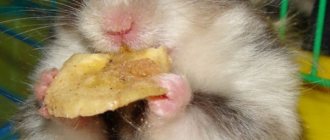- home
- Nutrition
19.03.2018
You always want to pamper your pets with various additives to their main diet. Unfortunately, not everything that seems tasty is healthy for hamsters. Before you feed your furry little friends, you need to find out how safe a particular product is for them.
A hamster needs vegetables regardless of the time of year, both raw and boiled. The daily intake should be at least 50 grams. Summer is replete with a variety of vegetables, including cucumbers. We need to figure out whether hamsters can eat cucumbers, how healthy they are, and in what form and quantity rodents are allowed to eat them.
Useful properties and composition of the fruit
Fresh cucumber is a dietary product containing many vitamins and microelements. In addition, it consists of 95% water, which flushes the kidneys and removes toxins from the body. The familiar green vegetable is simply a storehouse of minerals:
- potassium (necessary for blood vessels and heart);
- magnesium (reduces the risk of heart disease);
- fluoride (has a beneficial effect on bone tissue);
- iodine (has a beneficial effect on the thyroid gland);
- sodium (participates in the production of gastric juice);
- zinc (strengthens the immune system);
In terms of fiber content, it is a leader among other vegetable crops. Need I mention that consumption improves intestinal motility and gently cleanses it, and is a prevention of diseases of the cardiovascular system.
It is recommended to give cucumbers that are grown in season. Since for early harvesting nitrates are added, which in small quantities will not harm humans too much, but even small portions can be destructive for the animal.
Is it possible to give hamsters large cucumbers?
It is advisable to give Syrian or Djungarian hamsters small fruits, since the concentration of ascorbic acid in them is an order of magnitude higher than in grown specimens. In any case, the compounds of iodine, chlorine, phosphorus and magnesium contained in the pulp will have a beneficial effect on the general well-being of the rodent, enrich the body with a complex of useful substances and strengthen immune properties.
- phosphorus and magnesium are essential components of rodent bone tissue;
- iodine is an important component of the hormone “Thyroxine”, which is responsible for the functioning of the thyroid gland;
- chlorine is a component of blood that maintains cellular pressure;
- potassium is a participant in protein metabolism and a regulator of water content in body tissues.
Cucumbers in the diet of Djungarik and Syrian hamsters
Djungarians and Syrian hamsters are the same animals as their relatives. They like to store cucumbers and other leftover food in reserve.
The consequence may be poisoning. It is better to remove half-eaten cucumbers from the cage after feeding, so that stale vegetables do not cause your pet to become ill. In addition, babies have a very sensitive digestive system, and you should not overdo it with cucumbers. It should not be given in large quantities.
You can give your Syrian hamster cucumber. It will help with constipation and is a good dietary product. An excellent remedy for obesity, which is often found in this type of hamster. In addition, they have diabetes, sweet vegetables are contraindicated, but a cucumber will only be beneficial. It is better to choose medium-sized fruits; they contain more ascorbic acid.
Give complementary foods in small portions. Choose clean products without damage or signs of rotting.
In what form can it be given?
When choosing a green treat for your pet, you should give preference to those cucumbers that were collected during their natural ripening period. If the products are purchased at the market or in a store, and not grown in your own garden plot, you need to pay special attention to the pre-processing of vegetables. The top of the fruit will be safer for the rodent, since most of the nitrates accumulate at the base.
Important! Pesticides and various chemicals used to accelerate the growth of fruits pose a real threat to the life and health of the hamster.
Fresh
It is best to give your pet fresh vegetables, which contain the maximum amount of vitamins and nutrients. Before use, they should be thoroughly rinsed under running water. If you are not sure about the “safety” of the product, it is recommended to soak the cucumbers for several hours in cold water - during this time the nitrates will partially dissolve, and their elasticity and juiciness will increase. It would not be superfluous to peel the vegetable, especially if it is bitter.
Syrian hamsters should be offered fresh cucumbers based on their general condition. If an animal suffers from constipation, this vegetable, which has a laxative effect, is simply necessary for it. However, if the rodent has diarrhea, consumption of this product is not recommended. Djungarian and Chinese hamsters, who are prone to excess weight and diabetes, will only benefit from cucumber “desserts”.
Video: can a hamster have a cucumber?
Canned
Canned fruits can successfully replace fresh vegetables in the cold season. However, this alternative is not suitable for furry pets. Hamsters should not be fed canned cucumbers. This rule applies to representatives of all domestic breeds. Heat treatment in combination with preservatives makes the product dangerous to the health of the animal.
Salted and pickled
Cucumbers treated with salt, sugar, spices and vinegar are prohibited from being added to the diet of hamsters. Salt causes urinary system diseases in rodents. Spices and vinegar negatively affect digestion and can cause allergic reactions. And sugar increases the already high risk of developing diabetes in dungarian and Chinese hamsters.
Important! Cucumbers can quench thirst, but they are not able to replace water, so we must not forget about the drinking regime.
We treat you to vegetables
They are given to the sweet baby in raw form. And for some reason, the first question for most inexperienced owners is whether it is possible to feed a hamster with cucumbers and cabbage. The list of allowed vegetables is presented below:
- Carrot.
- Bulgarian pepper.
- Zucchini and squash.
- Fresh corn.
- Fresh peas.
- Beets in small quantities.
- Pumpkin.
And finally, the answer to the question: can hamsters eat cucumber? Yes, it is possible and necessary. Only previously peeled.
Preparing for the arrival of a hamster in the house
Before buying a Djungarian hamster, it will be useful to know what types of rodents there are. Thanks to the variety of colors, each person can choose a pet to their liking. The most common coat color is wild or standard. These hamsters have gray-brown fur.
Read also: Weightlifting shoes
Other popular colors are bred artificially:
- pearl is a white Djungarian hamster;
- sapphire – blue-gray fur;
- mandarin – light brown fur with reddish tint;
- brown;
- black;
- chocolate.
Reference. There are no albino Djungarian hamsters. The breed contains individuals with light beige and light ash fur. Animals with this coloring appear almost white.
Why are cookies harmful?
Hamsters have a very low tolerance for sweets, salty and fatty foods. Especially harmful for Djungarian hamsters, which are predisposed to diabetes. You can occasionally offer your hamster dry, unsalted biscuits. But we are not immune from the fact that even such store-bought cookies contain a lot of harmful additives and chemicals. They have a detrimental effect on the liver and digestive tract of the rodent. Salt, which is very high in crackers, damages the heart and kidneys. As a result, the immune system weakens and other vital systems suffer. A hamster with a cookie looks very cute, crunches funny, and crumbs remain on its antennae. But you shouldn’t risk your pet’s health to admire this picture; it’s better to choose a healthy alternative to the treat.
Without protein you can't go anywhere
The protein component must be present in the rodent's diet. So what could it be? Boiled chicken meat, for example. Naturally, cooled, without bones and skin. What else can you offer a rodent?
- Boiled lean beef.
- Boiled fish without bones.
- Low-fat fermented milk products.
- Boiled eggs.
- Live food: bloodworms, mealworms, earthworms.
Protein is given to the hamster no more than 2 times a week. For example, on Monday you can treat your pet to chicken, and on Saturday you can pamper your pet with a piece of boiled egg. All products must be free of salt and spices.
Differences in care and maintenance
Djungarian and Syrian hamsters differ in the nuances of care and maintenance.
Representatives of both breeds need their own territory in the form of a spacious cage. It is worth choosing a home with the minimum bottom parameters – 15*30 cm.
Active and mobile dwarfs need space and exercise. The cage needs to be equipped with tunnels, passages, and a running wheel should be placed near the house. If the grate is shallow, then the nimble miniature rodent will not escape from there.
Syrian hamsters, unlike Djungarian hamsters, benefit from a spacious multi-story cage with tunnels and labyrinths. They need a lot of space due to their large body size. Representatives of this breed are smart, so they will leave their home without any problems if the door has a simple latch and the space between the bars is too wide. Therefore, golden hamsters need to buy a metal cage with a plastic tray and a secure lock on the door.
In the wild, the animal is capable of running several kilometers per night when fleeing from predators or in search of food. In captivity, special accessories will help you throw out excess energy: a running wheel, slides, labyrinths, tunnels, passages.
With a lack or absence of physical activity, animals begin to develop health problems:
- obesity;
- diseases of the heart and blood vessels;
- weakening of the immune system.
In addition to accessories for entertainment, the cage should be equipped with a small house for the hamster, a drinking bowl with a retractable limiter and a feeder. The owner must make sure the pet understands how it works. The water should be changed 2 times a day to keep it fresh, and the drinking bowl should be washed regularly.
Cage bedding and a sand or ash bath will help get rid of unpleasant odors and parasites. Representatives of both types of hamsters like to bury themselves in sawdust to sleep. You should not bathe your pets in water, it causes them stress.
In general terms, the diet for Djungarian hamsters does not differ from the menu for Syrian hamsters. High-quality store-bought food contains almost all the beneficial substances that a rodent needs. The diet is supplemented with vegetables, herbs, fruits, berries, and protein foods. But for Djungarian rodents, you need to select foods that contain less sugar, as they are prone to diabetes.
The feeding regimen of dwarf hamsters does not differ from the routine of Syrians - 1 or 2 times a day. They eat in the evening or evening and early morning
It is important to ensure they have access to food so they can snack when needed. The daily portion of food for Syrian hamsters is about 100 g, and for Djungarian hamsters - no more than 30 g
Pets periodically need to be given rough food to wear down their incisors. These can be walnuts with shells, tree branches.
Djungarian hamsters are no different from Syrian ones in the need to create a supply of food
It is important to regularly check the cage for the presence of such “pantries” to remove spoiled food. If a hamster eats it, it will get poisoned
For the same reason, you should regularly remove leftover food from the feeder after a meal.
It is better to keep Djungarian and Syrian hamsters in a separate cage. However, the former are more loyal to their brothers, so they can exist in a team. To reduce the likelihood of conflicts, you need to provide your pets with a spacious cage with separate houses, running wheels and feeding accessories. Then they will intersect less often and will be able to live peacefully. Golden hamsters live separately from other pets.
Rodents of different sexes are housed together during female estrus for mating. This process takes no more than 24 hours, then it is advisable to place them in separate cells. Otherwise, the female attacks the male.
The gestation period for Djungarian hamsters is 20–26 days, and for Syrian ones – 16. The former give birth to 1 to 11 babies, and the latter – from 8 to 10.
After 3–5 weeks, it is better to resettle the female and her cubs, otherwise she may kill or eat them. After this time, the hamsters switch to adult food.
If representatives of both breeds hibernate, this may be due to a decrease in temperature, lack of light, poor nutrition, and stress. In most cases, the pet needs to be woken up, and errors in care and maintenance must be corrected.
Is it possible to allow a hamster very large portions?
Having clarified whether hamsters can eat cucumbers, it is necessary to take into account the amount of crunchy fruits in order to avoid overfeeding and unbalanced diet. It is important to remember that the measure is the key to the pet’s health. It is rare that a hamster will refuse the opportunity to have a snack, but the animal should not be given excessively large portions.
Despite the comprehensive usefulness of fresh cucumber, it is necessary to provide the rodent with gastronomic variety. Between cucumber portions, treat the animal with greens and grains, specialized food and do not forget about the drinking bowl, which should always be full of clean water. Cucumbers are a great thirst quencher, but you shouldn’t hope that they can replace regular drinking.
Which hamster is better: Djungarian or Syrian
Both Djungarian and Syrian hamsters need proper care. To understand which hamster is best to get, the future owner must take into account his character and lifestyle.
If the owner spends the whole day at work or periodically leaves home for 1–2 days, then a dzhungarik will be more suitable for him. It is better to buy 2 hamsters from the same litter and place them in a spacious cage with separate accessories, then they are unlikely to conflict. If you provide them with food and drink, they will not even notice the absence of a person.
If the future owner wants to have contact with the animal, then the Syrian hamster will become an excellent friend. Some owners allow the animal to spend all its waking hours in freedom; they are sent into the cage only to sleep
The golden hamster meets the owner if he has gone somewhere, climbs into his arms, and attracts attention to himself
Parents are always unsure which hamster is better to buy for their child - Djungarian or Syrian. If the future owner is under 5 years old, then it is recommended to choose a Syrian.
He is larger, phlegmatic, and has good contact with people. But it is better to buy a pet no younger than 2 months. Using the example of a calm animal, a child will learn to care for rodents: clean the cage, feed.
Djungarians can easily escape from their little owner if he opens the cage to change the bedding or put in food
In addition, the latter can bite the child if handled carelessly, then stress is guaranteed for both
Which hamster is suitable for a child over 5 years old, he will decide for himself. The main thing is to teach him to be responsible and treat animals with care. Adults should supervise the care process.
The Syrian hamster is more suitable for children, as they love to cuddle, pet, play, and train. In addition, they live longer, and Djungarians often do not live up to 2 years
Thus, Djungarians are more suitable for adults who do not need physical contact, are often not at home, and can keep 2 pets. Syrian hamsters will bring joy to children and adults who want to pet, hold and train the animal.
In both cases, you need to provide the hamster with spacious housing, necessary accessories, proper care, care and love.
Let's sum it up
Hamsters can eat cucumbers, but they must be fresh and in season. It is acceptable to include this vegetable in your pet’s daily diet, but before eating it, it is advisable to first rinse and soak it in water. This product should not be given to young rodents that have not yet reached the age of one month.
If you follow simple rules, cucumber will become a healthy and thirst-quenching food for your pet.
Did you like the article? Share with friends: [supsystic-social-sharing id=”1"]
- Related Posts
- Can hamsters eat pomegranate?
- Can hamsters eat nuts?
- Can hamsters eat zucchini?
« Previous entry
Briefly about feeding
How should you feed your hamster? Should food be kept in the cage at all times? It should be borne in mind that a pet is a thrifty creature. And he will definitely hide food in his cheek pouches, carefully take it to the house and place it in a secluded corner. The rodent is fed twice a day. In the morning they pour a bowl of food and give him something tasty, in the evening the same scheme. There should be constant water in the drinking bowl. It is changed daily, and care should be taken to ensure that the drinking bowl is full. Once a week, the cage is disinfected, along with the feeders and drinking bowls.
Gender is strictly prohibited
Finally, it’s time to talk about those foods that should never be given to a hamster. These include:
- Cheese.
- Bread.
- Potato.
- Cabbage.
- Spices.
- Fatty, fried, smoked foods.
- Sausages and sausages.
- Watermelon.
- Avocado.
- A pineapple.
- Sour cream, milk, butter.
- Mushrooms.
- Pasta.
- Chocolate.
- Ice cream.
- Honey.
- Paste.
- Marshmallow.
- Sparkling water.
- Juices.
- Candies and chewing gum.
In general, it is forbidden to give your pet everything that is considered tasty for a person. Such a treat can cause irreparable harm to a hamster, even death.
Benefits and harms
Fresh cucumbers are a dietary product, rich in nutrients, and also a good way to quench your thirst. They are 90% water. Contains vitamins B, C, iodine, fluorine, potassium, calcium, phosphorus and sodium. Microelements are necessary for rodents to strengthen teeth and bones, and other vitamins and microelements are necessary for the proper functioning of the heart, nervous system, and metabolism. They are also an excellent anti-constipation agent and help cope with excess weight in obesity.
Hamsters happily gobble up cucumber pulp, however, you need to be careful. Rodents under 1.5 - 2 months of age should not be treated in this way - they may not digest what they eat very well and will suffer from diarrhea for some time. Adult rodents can be offered cucumbers no more than once a day. The main thing is to observe moderation in everything, as this is very important for the health of your pet.
Fruits
We sorted out the question of vegetables and the question of whether hamsters can have fresh cucumbers. Now let's move on to fruits. So often you want to pamper your funny hamster with something tasty and healthy. But what can you give a rodent? What fruits will not harm the health of the baby?
First of all, hamsters can't eat citrus fruits. Secondly, their diet should not contain “overseas” fruits. For example, kiwi and bananas. And before you treat the animal, you need to wash the fruit, ideally scald it with boiling water and cut off a small piece. The list of healthy fruit goodies is below:
- Apples.
- Pears.
- Peaches.
- Apricots.
- Plums - a little.
- Dried fruits: raisins, dried apricots, dried apples.
Fruits must be fresh and in no case rotten or spoiled.
How to feed?
Tomatoes should be introduced into the hamster’s menu gradually. Start literally with 5 grams, observing the pet’s further reaction. In case of negative manifestations (allergies, diarrhea), stop feeding. For clarity: the average size of a cherry fruit is 10 - 30 grams. This is exactly the one-time norm of tomato complementary feeding for an adult rodent. Giving tomatoes to your hamster 1 - 2 days a week will be enough.
Pregnant and lactating females, as well as cubs, should not be given these vegetables; it is better to choose other vitamin supplements. Tomatoes should not be mixed with protein feed. If your pet refuses to eat vegetables, there is no need to insistently offer them; usually animals instinctively choose what is best for them.
Possible problems in the diet of dzhungarika
The Djungarian hamster is a tiny animal (the average weight of an adult is about 50 g). This somewhat shortens the list of what you can feed your pet: what is good for other rodents is death for the dwarf. For example, almonds contain hydrogen cyanide, which is harmless to larger pets but can easily poison your hamster.
The second important point is that Djungarians are prone to obesity and diabetes. They should not be overfed, given sweets, or fed with very sweet flour and fruits. Even though they love banquets, we put them on a strict diet.
I can do it, I can do it without cookies!
What can a dwarf hamster eat?
The delicate stomach of these animals is not suitable for digesting fatty foods and sweets. When thinking about what to feed Djungarian hamsters at home, the easiest way is to focus on what they eat in the natural environment. In the wild, the animals eat a lot of grains and seeds.
In spring and summer, herbs, berries and insects additionally appear in their diet.
The list of what Djungarian hamsters can eat includes three categories of food:
Ideally, the diet of a Djungarian hamster should include:
Like other rodents, the Djungarian hamster has continuously growing teeth, so in order to wear down its incisors, its diet must be enriched with solid food.
Grain mixtures
Djungarian hamsters can be fed commercially produced dry food. Depending on the brand, they contain different components. Some manufacturers produce simple food for Djungarian hamsters, which includes cereal grains (oats, wheat), grass granules, sunflower seeds and dried fruits.
Others fortify their products with bone meal, brewer's yeast and vitamins.
Important! When choosing a ready-made grain mixture that you plan to feed your dwarf hamster at home, you need to pay attention not only to the shelf life, but also to its composition. The food should not contain raisins, honey granules or candied pineapple.
Fruits and berries
From 14 days of age, Djungarian hamsters can be given moderately sweet fruits. In order not to harm the small rodent, fruits are pitted in advance, since they contain toxic substances. Djungarian hamsters are very fond of apples, apricots, pears, bananas and plums.
Important! Most fruits contain high concentrations of glucose and carbohydrates, an excess of which is harmful to dzungarians. Therefore, juicy fruits can be fed to hamsters in strictly dosed quantities.
It is recommended to periodically introduce seasonal berries into the diet of small pets. Djungarian hamsters eat with appetite currants, rose hips, strawberries, rowan berries, barberries, hawthorns, lingonberries, pitted cherries, raspberries and wild strawberries.
Vegetables
These products contain virtually no glucose. Animals are allowed to eat the following vegetables:
Important! The Djungarian hamster should only eat vegetables that contain a lot of fiber and little starch.
Greenery
To avoid vitamin deficiency, the Djungarian hamster's diet must be enriched with green food. To do this, it is advisable to introduce lettuce, dill, parsley, nettle, clover, dandelion, plantain leaves, beet and carrot tops into the rodent's diet. It is better to grow greens yourself or collect them away from busy highways and industrial areas.
Important! It is forbidden to feed Djungarian hamsters with greens with a high content of acids and essential oils, such as sorrel, green onions, garlic.
Protein food
Djungarians can be fed protein foods. Suitable source of proteins for animals:
Protein food can be given to Djungarian hamsters once a week, and to pregnant females and cubs - 2-3 times more often.
Dairy
Rodents require calcium to strengthen their teeth and bones. Therefore, Djungarian hamsters can eat low-fat fermented milk such as kefir, homemade yogurt and cottage cheese.
Bread, nuts, dried fruits
The Djungarian hamster eats with appetite not only fresh, but also dried fruits. It can be fed with raisins, dates, dried apricots, figs and bananas, previously soaked in water.
Bread, especially rye bread, is not the most suitable food for Djungarian hamsters. To bake it, yeast, baking powder, salt and chemically treated flour are used, which are bad for the health of the animals.
Nuts are sources of tocopherol, vegetable protein and polyunsaturated fatty acids. Peanuts, cashews and hazelnuts are allowed on the Djungarian menu. Nuts can be fed to hamsters exclusively in peeled form and no more than once a week.
What to feed a pregnant and lactating female Djungarian hamster?
Pregnant and lactating females and juveniles require a diet high in protein. On average, proteins should make up 12-15% of his total diet. The amount of feed should be increased by about 1/3. If this is not done, then the female may begin to kill part of her offspring and eat it, since she needs protein to raise the rest.
The nutrition of juveniles is similar to that of adult animals, except that they should be given protein food more often; the female will take care of the smallest ones.
Additional recommendations
Hamsters begin to age at 15 months of age. This is reflected in the deterioration of the health of their heart, respiratory and digestive systems, and teeth. To avoid a decline in quality of life, from this age more vitamins and mineral baits need to be introduced into the hamster’s diet.
Hamsters are nocturnal animals, so it is advisable to communicate with them closer to the dark - in the morning or evening. It is undesirable to disturb an animal during the day or disrupt its sleep pattern - this leads to aggression and health problems.
How to toilet train a hamster
Buy a toilet with small sides at a pet store. Animals often choose the corner of the cage, so it is better to choose a corner toilet. The filler may come included; if not, choose the one you bought for regular bedding.
Keep the toilet away from the feeder. Djungarik will not walk into it right next to food.
Do not install a hamster litter box immediately after your hamster arrives. It's better to watch the animal for the first week or two. He can choose a convenient place on his own.
Hamsters go to the toilet in the corner, which is why corner toilets are popular
If your Djungarian hamster is sleeping or stocking up in the toilet, think about the reason for this behavior. Maybe he’s just not satisfied with an ordinary house. Perhaps it is too cramped or difficult to get to (if it is on the second floor, for example).
Do not demand instant submission from the fluffy and do not punish. You may need two toilets, because the hamster sometimes chooses two corners, everything is individual here. It may take several days for him to get used to the new object.
Can a hamster get cucumbers from the store?
Buying vegetables in a store or market is fraught with a high content of nitrates, which can provoke poisoning in an adult, not to mention a small animal, whose body is tens of times smaller. If it is not possible to test the fruits for the concentration of harmful substances, give the hamster the plant in small portions and peel off the peel. It is safer to treat your pet with the top part, since the bulk of nitrates collects at the base of the fruit.
You can please your pet with cucumbers grown on your own plot more often. In domestic plants, the amount of harmful substances is minimal or completely absent if the plantings have not been treated with chemicals. You can feed your hamster with juicy pulp after one month of age, and by the age of 1.5 years, vegetables should be included in the rodent’s regular diet.
Cucumbers will be a useful addition to your pet’s diet if you maintain balance and do not overfeed your pet with green vegetables. It is very important to offer only fresh fruits, excluding pickled varieties. It is recommended to always clean the skin to protect the hamster from unwanted consequences, since they are very sensitive to pesticides even in small quantities.
When creating a thoughtful diet for a rodent, consisting of a variety of plant crops, do not forget about the additional vitamin complex. The presence of useful elements in food does not guarantee the animal a complete set of micro- and macroelements, so the correct selection of vitamins is indispensable for a pet.
Feed the animal cucumbers that you are completely sure are safe. If in doubt, it is better to treat your hamster with food from a pet store and not risk his health.
Black and white bread
In natural wild conditions, bread is inaccessible to rodents, unless they live near populated areas. Only domestic hamsters can enjoy it, but veterinarians unanimously do not recommend feeding them fresh flour products.
White flour is made from wheat, which is always present in dry mixes, and is acceptable and healthy for your hamster. However, in the process of grinding and processing, grain changes not only its structure, but also its qualitative composition. The product is additionally bleached to make it look presentable and last longer. As a result, the flour is deprived of most of its vitamins, minerals and beneficial fiber.
The resulting starch is a heavy carbohydrate; it can cause obesity in a hamster and, as a result, diabetes, as well as joint problems. In addition, it has the following negative effects on the body:
- negatively affects the functioning of the urinary system;
- provokes disruptions in the normal functioning of the adrenal glands and pancreas;
- leads to disruption of the endocrine system (thyroid gland).
Yeast is added to the dough kneaded for bread, as well as leavening agents, flavorings, stabilizers and other synthetic additives. A hamster's consumption of these completely unhealthful components is fraught with digestive disorders, manifested by increased gas formation and even (in rare cases) alcohol poisoning (due to yeast fermentation). Yeast is especially dangerous because it can radically change the intestinal microflora.
If you give a hamster bread, he will develop quite painful conditions:
- flatulence, vomiting, nausea;
- diarrhea;
- refusal to eat due to loss of appetite;
- breathing problems (choking);
- lethargy and decreased activity;
- heart failure;
- disorientation;
- and even death.
The same attitude applies to black bread, because it is also made with yeast. Although rye flour is less starchy, and there is no need to bleach it, hamsters still cannot eat baked goods from it. The ban is associated with the increased acidity of the baked product, due to which disturbances in the gastrointestinal tract are observed. If you give a hamster rye or black bread, it can cause:
- heartburn;
- gastritis;
- constipation;
- colitis;
- ulcer.
Crackers
If fresh bread has no place on the hamster’s menu, then the attitude towards crackers is different. After all, during heat treatment (drying in an oven), most of the yeast fungi die. Dried bread pieces (both wheat and rye) contain enough fiber, much less carbohydrates, and also contain a number of essential and beneficial minerals (Mg, Fe, Ca). Considered dietary, dried bread no longer causes fermentation; when consuming it, the hamster does not experience flatulence. Rusks normalize the functioning of the gastrointestinal tract and restore metabolic processes in the endocrine system.
On store shelves there is a huge assortment of crackers already prepared and packaged in beautiful wrappers; it is tempting to buy and pamper your pet hamster with them. But this should not be done under any circumstances, since all sorts of flavor enhancers, flavorings and stabilizers are added to purchased products at the factory. These substances, even in small quantities, are deadly to small rodents. It is more desirable and much safer to dry bread yourself, giving preference to grain and bran products.
List of permitted and prohibited foods for the Djungarian hamster
Content
Dzungariki are small decorative rodents with an accelerated metabolism and excellent appetite. The funny animals are constantly chewing something and are able to eat up to 70% of their body weight in a day.
True, the habit of eating everything can cost them their health and sometimes their lives. Therefore, the owner of a Djungarian hamster needs to know what can be fed to the pet and what is prohibited.
